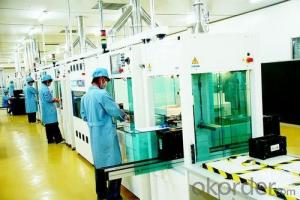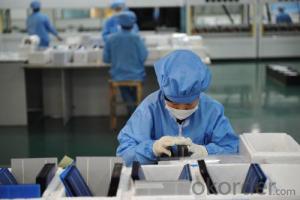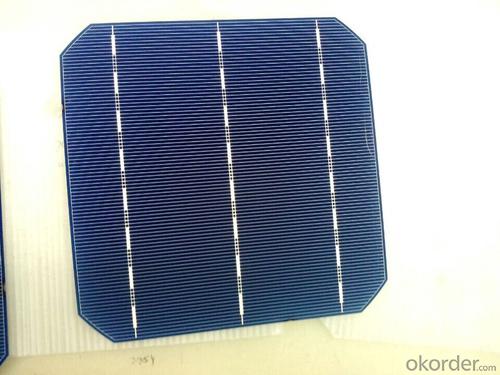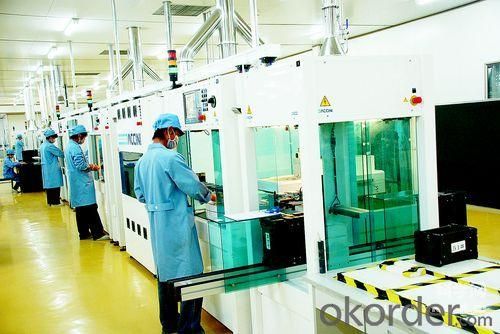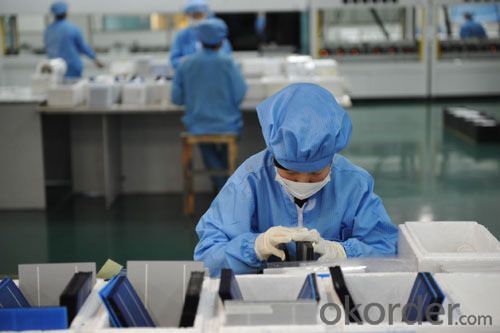Stackable Solar Cells - 156*156mm Monocrystal Solar Cell with 4.65 Watt High Efficiency
- Loading Port:
- Shanghai
- Payment Terms:
- TT or LC
- Min Order Qty:
- 1000 pc
- Supply Capability:
- 20000000 pc/month
OKorder Service Pledge
OKorder Financial Service
You Might Also Like
Brief Introduction of Solar Cells
A solar cell, is an electrical device that converts the energy of light directly into electricity by the photovoltaic effect, which is a physical and chemical phenomenon. It is a form of photoelectric cell, defined as a device whose electrical characteristics, such as current, voltage, or resistance, vary when exposed to light. Solar cells are the building blocks of photovoltaic modules, otherwise known as solar panels.
Monocrystal solar energy cell
Type:156M
Appearance:156×1565㎜±0.5mm; Diagonal:R=100mm
Main fence wide:1.4-1.5mm Back electrode wide:2-2.5mm
Fence line qty:90
Cell thickness:220um±20um
Eff(%) | 19.0- 19.1 | 19.1- 19.2 | ||||||||||
Pm(W) | 4.54 | 4.56 | ||||||||||
Isc(A) | 8.9 | 8.93 | ||||||||||
Im(A) | 8.47 | 8.51 | ||||||||||
Voc(V) | 0.638 | 0.64 | ||||||||||
Vm(V) | 0.537 | 0.538 | ||||||||||
FF(%) | 80 | 80 |

remark:our company cells as per working current concentrate principle,separate the first and the second grade
Advantage of Polycrystalline Solar Cells
World’s Leading Manufacturer Equipment. We imported the newest and leading production equipment from abroad. Advanced equipment can guarantee the stable quality of cells. Auto production line can also save labor cost which will further cut our production cost.
Bulk supply: With the production capacity of 500MW, we can produce large quantity every month. This can satisfy most customer requirement.
Factory Picture of Solar Cells

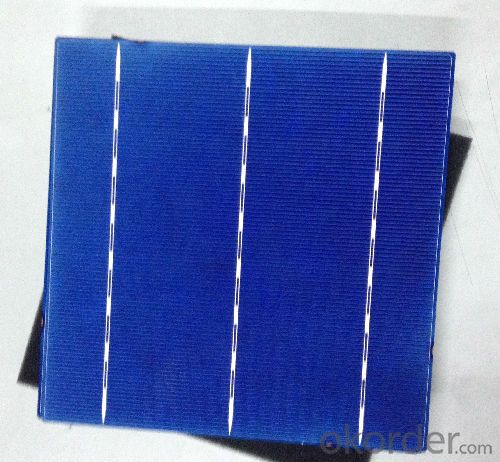
FAQ
We have organized several common questions for our clients,may help you sincerely:
What’s price per watt?
A: It’s depends on the quantity, delivery date and payment terms of the order. We can talk further about the detail price issue. Our products is high quality with lower price level.
Can you tell me the parameter of your solar cells?
We have different series of cells with different power output, both from c-si to a-si. Please take our specification sheet for your reference.
How do you pack your products?
We have rich experience on how to pack the panels to make sure the safety on shipment when it arrives at the destination.
Can you do OEM for us?
Yes, we can.
How long can we receive the product after purchase?
In the purchase of product within three working days, We will arrange the factory delivery as soon as possible. The perfect time of receiving is related to the state and position of customers. Commonly 7 to 10 working days can be served.
- Q: What is the impact of extreme temperature fluctuations on solar cell efficiency?
- Extreme temperature fluctuations can have a significant impact on solar cell efficiency. When the temperature rises, solar cells tend to generate less electricity due to increased resistance and decreased voltage. Conversely, in colder temperatures, solar cells may experience higher efficiency initially, but this could be offset by reduced performance as the temperature drops even further. Therefore, extreme temperature fluctuations can lead to a decrease in overall solar cell efficiency, affecting their ability to harness and convert sunlight into usable electrical energy.
- Q: What is the most common type of solar cell?
- The most common type of solar cell is the silicon-based solar cell.
- Q: Can solar cells be used in hybrid systems?
- Yes, solar cells can be used in hybrid systems. Hybrid systems combine different sources of energy, such as solar, wind, or fossil fuels, to generate electricity. Solar cells can be integrated into these systems to harness solar energy and contribute to the overall power generation. This allows for a more sustainable and efficient energy production, reducing reliance on traditional energy sources.
- Q: How do solar cells perform in areas with high levels of volcanic ash?
- Solar cells may not perform optimally in areas with high levels of volcanic ash. The ash particles can accumulate on the surface of the solar cells, blocking sunlight and reducing their efficiency. Regular cleaning and maintenance may be required to ensure the cells continue producing electricity effectively.
- Q: How do solar cells perform in areas with high levels of salt spray?
- Solar cells generally perform well in areas with high levels of salt spray. However, prolonged exposure to salt spray can potentially corrode the surface of the cells, reducing their efficiency over time. Regular maintenance, such as cleaning and protective coating, can help mitigate the effects of salt corrosion and ensure optimal performance.
- Q: Can solar cells be used in countries with limited sunlight?
- Yes, solar cells can still be used in countries with limited sunlight. While solar cells generate the most electricity under direct sunlight, they can still generate power even in cloudy or overcast conditions. Additionally, advancements in solar panel technology have made them more efficient in capturing diffuse sunlight, enabling their use in regions with limited sunlight.
- Q: How are solar cells different from solar panels?
- Solar cells are the individual units that convert sunlight directly into electricity, while solar panels are a collection of these cells that work together to generate a larger amount of power.
- Q: What are the different types of solar cells?
- There are several different types of solar cells, including monocrystalline silicon, polycrystalline silicon, thin-film, and multi-junction solar cells.
- Q: How much do solar cells cost?
- The cost of solar cells can vary depending on various factors such as the type and size of the system, installation requirements, location, and quality of the panels. On average, residential solar panel systems can range from $10,000 to $30,000 or more. However, it is important to consider long-term savings on electricity bills and potential government incentives that can offset the initial investment.
- Q: What is the role of solar cells in powering water pumping systems?
- Solar cells play a crucial role in powering water pumping systems as they convert sunlight directly into electricity. This renewable energy source eliminates the need for traditional power sources and reduces the reliance on fossil fuels, making water pumping systems more environmentally friendly and sustainable. Additionally, solar cells provide a reliable and cost-effective solution, particularly in remote areas where access to electricity may be limited, ensuring that water can be pumped efficiently for various applications such as irrigation, agriculture, and domestic use.
Send your message to us
Stackable Solar Cells - 156*156mm Monocrystal Solar Cell with 4.65 Watt High Efficiency
- Loading Port:
- Shanghai
- Payment Terms:
- TT or LC
- Min Order Qty:
- 1000 pc
- Supply Capability:
- 20000000 pc/month
OKorder Service Pledge
OKorder Financial Service
Similar products
Hot products
Hot Searches
Related keywords

